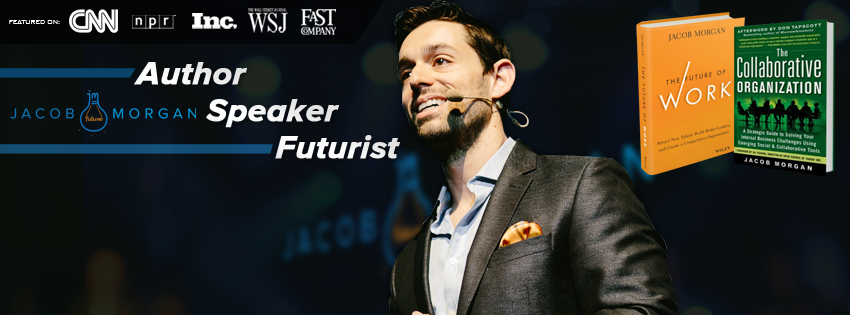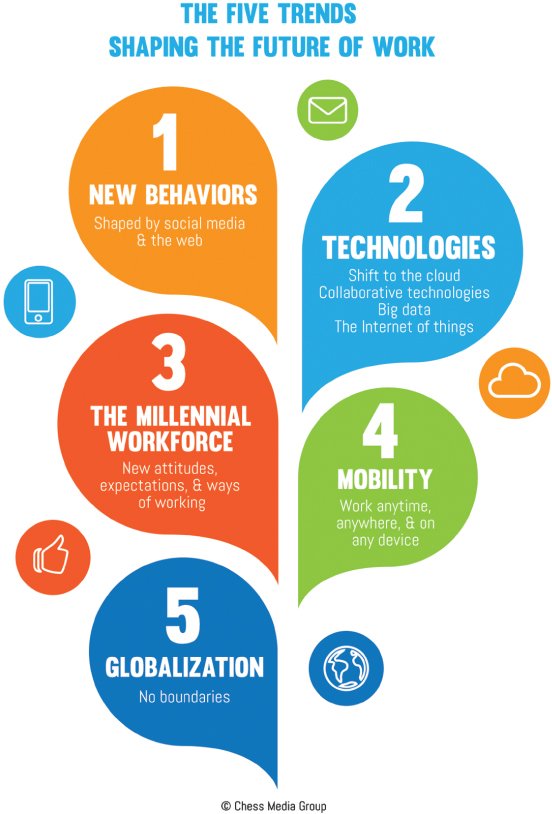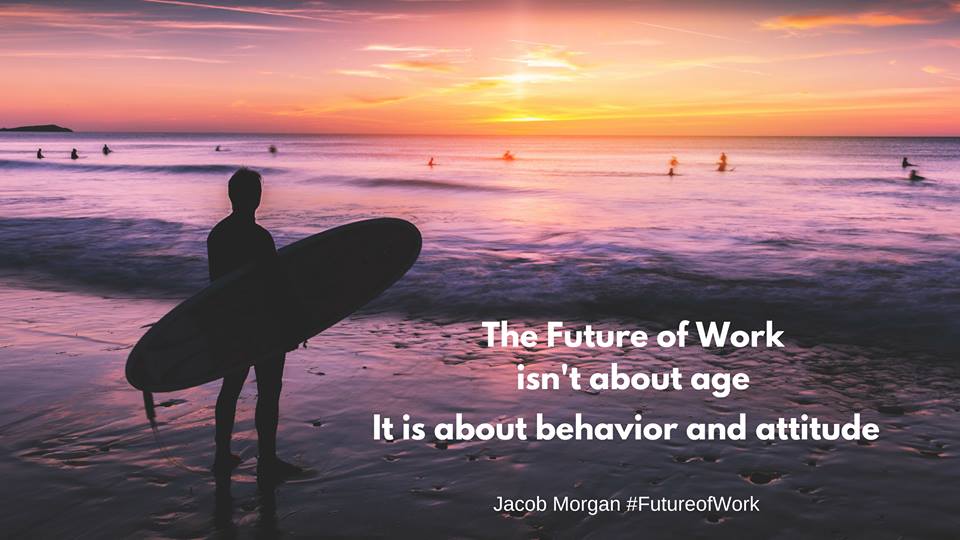The Future of Work Talk - Interview With Jacob Morgan

Posted by TallyFox on 28 April 2016
In today’s world, the focus is on the employee, as the employee experience is very important to attracting and keeping new talent.
Many companies are investing a great deal of money and time in building attractive office spaces, deploying new technologies and establishing a company culture. There is one man who is helping them do that and his name is Jacob Morgan.

He wrote two best selling books “The Collaborative Organization: A Strategic Guide to Solving Your Internal Business Challenges Using Emerging Social and Collaborative Tools” and “The Future of Work: Attract New Talent, Build Better Leaders, and Create a Competitive Organization” to help companies build a better employee experience, and he tops it off with his keynotes, his blog, podcast, columns in Forbes, WSJ (to mention a few) and his work in the Future of Work Community.
In case you wondered, he does sleep, we asked.
TallyFox: In 2012, in your first book, you talk about using social and collaborative tools to empower collaboration, and your latest book is focused on around attracting new talent, building better leaders, and creating a competitive organization. Has the focus generally shifted from tools to employees?
Jacob Morgan: Well, you need both, the tools are what enables employees to get the job done so you can’t really have one without the other, part of what I write about, and this isn’t in any of the books, but I wrote something called the Employee Experience Equation where I say that the key to designing employee experiences is about culture, physical space and technology, so as much as we want to say it’s all about the employees, we still need to enable and empower those employees and that’s where technology fits in.
TallyFox: Who should pick the tools that are to be used in the workplace: the IT department, the managers or the employees?
Jacob Morgan: I guess it depends on what the purpose is. If you as the employee are frustrated by the lack of tools your organization has, then I’m all in favour of going rogue and going against the company and just picking your own tools and using them in order to get the job done. In fact, if that happens quite often around the company, the organizations will have no choice but to think about using new tools. However, if your organization is providing you with relevant tools to use, then you should definitely use them.
That feedback from the employees, and from IT, should be a joined, unified effort. The managers should gather feedback on what their employees would like to use and why they would like to use it, instead of telling the employees what they should be using.
TallyFox: What software features would you say are needed to empower employees to collaborate?
Jacob Morgan: Every organisation would have its own needs, of course, but the most common ones would be: rich user profiles so people can search, features that emulate social tools people already use such as #tags, being able to easily @ mention people, attach files, have group discussions. I would also add a great search engine, single sign-on, mobile access or a mobile app which are very important, but all those things combined are very relevant and crucial.
TallyFox: What would be the advised way to start using new tools?
Jacob Morgan: You just buy it and deploy it, with doing some training around it. Organizations get stuck in all this talk about integration and migrating data, they might spend years trying to move from one technology to the other, by the time they do that, that technology is no longer relevant or something else has come along. I think that we need to become much more comfortable with moving faster, and being able to deploy these things quicker. If you find the technology you like, work with your IT department, work with the vendor to find out how you can best get that data and your employees onboard and make it searchable and accessible for other employees. The faster you can move onto the new technology and platform, the better.

TallyFox: How important is a knowledge base within the company and a facilitated access to expertise?
Jacob Morgan:Very important. You want your employees to be able to tap into the collective intelligence of your organization. Creating a knowledge base and having a technology where the employees can connect to each other is huge, so it’s great to have that kind of culture, mentality and mindset, but we have to realise that unfortunately it’s just not possible to do that without technology, and that is crucial.
TallyFox: The employees should also understand the benefits of sharing knowledge and using those tools. What would be the best way to handle that?
Jacob Morgan: You can’t force them to share and collaborate, so the most efficient way would be to present it to them so they see what the value is to them. Many organizations rarely focus on the impact and the value that this has for the individual employee.
What I think the organizations need to do is to shift the conversation from the benefit to the company to the benefit and the value to the individual employee. Why collaborate? Why use these technologies? How is this going to help you as an employee? Will it allow you to get more flexibility at work? Will it allow you to get more promotional opportunity and visibility? How is it going to impact you as an individual? If we can focus the conversation on that, then it is possible that the employees will be more open to sharing. Also, leading by example, making sure that executives, managers, senior leaders are the first ones to be using these technologies and those platforms, is very helpful.
TallyFox: We have recognised a need for companies to have real-time feedback about the product or the project they are working on. Our knowledge sharing platform, Tallium, allows organizations to open one community or a group to stakeholders/customers/clients to gather feedback and learn from it. How would you grade this option?
Jacob Morgan: It’s huge, anytime they are building something you would like them to get in touch with people that the product is going to be for, so I think it’s huge. Organizations definitely struggle with that but it's a crucial part to make sure that the products you are building are great products.
TallyFox: You speak about five trends that are driving the change in the workplace today. Can you share these with our readers?
Jacob Morgan: Sure. I talk about 5 trends that are shaping the future at work.
The Change of the Demographics would be the first one. Today’s workers have new attitudes, values, and expectations. This isn’t just a younger worker, a millennial, but a somebody that has a new way of thinking.
Mobility would be the second one - being able to stay connected anywhere, anytime on any device.
Globalisation is the third which is the idea that the world is becoming one giant city, barriers to doing business are collapsing.
The next one would be Technology: cloud computing, collaboration tools, big data, wearable devices, IOT; all these technologies which are entering our organizations are giving us new ways to work.
The fifth one is wrapped around New Behaviours.The new behaviour trend is the one we're seeing in our personal lives. When we want to talk to somebody, we Skype them, when we want to buy something, we do it online, when we want to watch something, we go to Netflix. If we have an idea about something we want to post, we go to Twitter, we put up pictures on Facebook and Instagram, we snap chat with each other so we have all these new behaviours which are shaping the way we share, communicate and create information. As a consequence, these new behaviours are entering our organizations, and oftentimes we don’t have the tools or we don’t have the culture to support that, so it becomes a challenge. You can do whatever you want in your personal life you can build your brand, share, collaborate, create, but once you set foot in your organization all that goes away and you’re teleported back to the 1980’s and you need to figure out the ways to do stuff.

TallyFox: What are the possible stumbling blocks in collaboration?
Jacob Morgan: I think that people do want to collaborate, give and get help from other people, but there are always a couple of barriers to it.
First one - not having the right technology can be a barrier, as we’re not always next to the people we need to collaborate with, so how do you collaborate with someone who is on another floor, across town, or across the world? We definitely need current technology to allow that to happen.
The second thing is having the culture of collaboration. If we see that the executives and managers are not collaborating and don’t believe in sharing, then why would the employees care? Also, if you ask for help, that shouldn’t be viewed negatively. There are some organizations that are so competitive that if you publicly ask for help, people are just going to think you’re an idiot, so you’d want to avoid having that kind of mentality within your organization.
The third reason could be the actual workspace that you have, if you tell employees that you want them to collaborate, share, be open,transparent, and then you make them sit in a cubicle and wear a suit and tie every day, that really doesn’t encourage collaboration either, so we have to really see how the environment impacts on the collaboration process.

TallyFox: Can you offer any advice on how to keep employees engaged?
Jacob Morgan: Well, for me it’s all about designing employee experience which as I mentioned earlier focuses on culture, technology and physical space. You give employees a space where they truly want to show up, you give them a physical environment where they enjoy working in, and you give them the tools that they need to be successful and productive. And if you focus on those three things, you should be able to create a place where employees want to stay longer and more at the company.
TallyFox: What is your view on the open-space concept when it comes to office design?
Jacob Morgan: I think it’s great. There’s a big debate between open offices and closed offices, which misses the heart of the argument, which is: It’s not about open or close, it’s about choice. Management should ask themselves: How can we give employees as many options and choices as possible to get the job done?”. I’m not a fan of picking out a one-floor plan and doing that for everybody, but your office should be like a house. In your house you have different rooms for different purposes and your office should be thought of the same way. To organizations that want to deploy open offices, I would say don’t just do that, try and have up to 10 different office layouts and floor plans so your employees can pick and choose how they wanna work.
Offices today are emerging as employee experience centers. The traditional office space is going to change and organizations will be creating these great spaces where people feel engaged and inspired to show up and actually want to show up.
TallyFox: What would you provide as advice on how to attract new talent?
Jacob Morgan: Design the employee experience, culture. Create a place where they want to show up and give them tools designed to enable their daily work to be done. As far as the new employees go, everybody wants to work for an organisation that has a sense of purpose, doing something for the greater good, where they have a great relationship with their manager and their co-worker, the corporate culture where the organizations need to understand and I think that every organization is going to do something different. There is not a one size fits all approach to everybody.
But there is one thing every company can do. Jacob defined it with these words: “I’d say open more doors and don’t close them, and try not to say no to employees when they want to jump into something else they want to get involved in, give them that freedom and that opportunity, and let them excel.”

Comments
Leave a comment